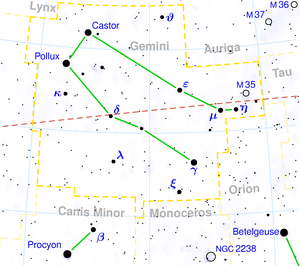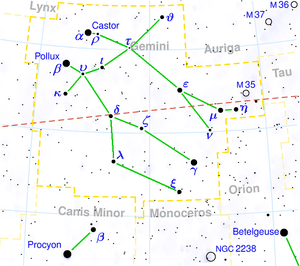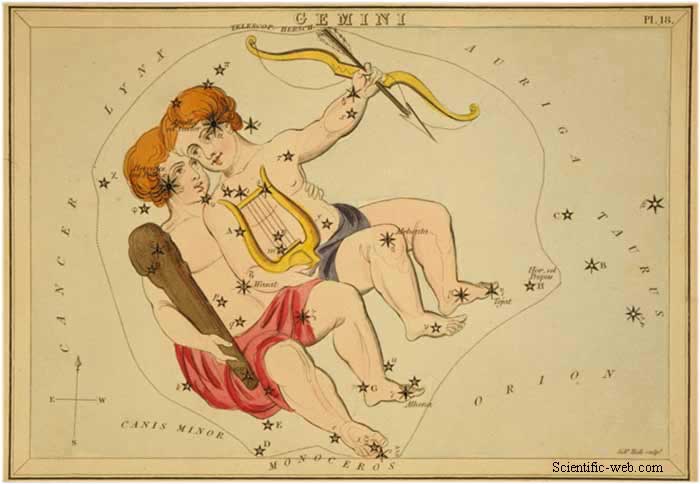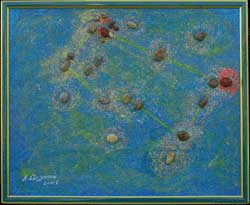|
|
Gemini ( Latin: twins, symbol , Unicode ♊) is one of the constellations of the zodiac known as "the twins". It is part of the winter sky, lying between Taurus to the west and the dim Cancer to the east, with Auriga and the near-invisible Lynx to the north and Monoceros and Canis Minor to the south. The Gemini program is named for it. Notable Deep Sky Objects Open Cluster M35. It also contains many interesting nebulas and star clusters. NGC 2158 is just southeast of M35. Also of note is the unique Eskimo Nebula, (also known as the Clownface Nebula) just southeast of the NGC 2420 open star cluster. Far northeast of this cluster lies NGC 2371, a planetary nebula next to the Gemini twin on the right. Another popular nebula in Gemini lies in the southern tip of the constellation, Abell 21 the Medusa Nebula. Also, there's something unknown at Dec 28°17'52.29" RA 7h46m21.75s . Mythology Since this constellation is easily viewable as two parallel stick figures [1], considering faint stars visible to the naked eye, it was associated with the myth of Castor and Polydeuces (also known as Pollux), collectively known as the Dioscuri. A myth of these twins heavily concerns cattle theft, and may be connected to early views of the Milky Way, as a herd of dairy cows or cattle, by which they are situated. The fatness of the constellation can vary (since they readily form stick figures whether leaning right or left), though the twins are usually viewed as left leaning. However, when right leaning, one of the twins resides in the Milky Way, and the other outside it, a situation making it appear that one of the twins is stealing the cattle, and the other is observing. In this situation, together with the area of the sky that is deserted (now considered as the new and extremely faint constellations Camelopardalis and Lynx), and the other features of the area in the Zodiac sign of Gemini (i.e. Orion, Auriga, and Canis Major), this may be the origin of the myth of the cattle of Geryon, which forms one of The Twelve Labours of Heracles. Astrology In tropical astrology it is associated with the decorated floral profusion of symbol for Gemini is the male lovers. Gemini are communicators of the Zodiac. They are also the nonconformists of the Zodiac. Graphic visualization The stars of the constellation Gemini can be connected in an alternative way, which graphically shows a pair of twins holding hands.
Diagram of an alternate way to connect the stars of the Gemini constellation. A pair of twins are shown holding hands. The twin to the right is Castor, whose brightest star is alpha Geminorum (more commonly called Castor), is of the second magnitude, and represents Castor's head. The twin to the left is Pollux, whose brightest star is beta Geminorum (more commonly called Pollux), is of the first magnitude, and represents Pollux's head. Pollux's torso is represented by star upsilon Geminorum, Pollux's right hand by iota Geminorum, Pollux's left hand by kappa Geminorum: all three of these stars are of the fourth magnitude. Pollux's pelvis is represented by star delta Geminorum, Pollux's right knee by zeta Geminorum, Pollux's right foot by gamma Geminorum, Pollux's left knee by lambda Geminorum, and Pollux's left foot by xi Geminorum. Gamma Geminorum is of the second magnitude, while delta and xi Geminorum are of the third magnitude. Castor's torso is represented by the star tau Geminorum, Castor's left hand by iota Geminorum (which he shares with Pollux), Castor's right hand by theta Geminorum: all three of these stars are of the fourth magnitude. Castor's pelvis is represented by the star epsilon Geminorum, Castor's left foot by nu Geminorum, and Castor's right foot by mu Geminorum and eta Geminorum: epsilon, mu, and eta Geminorum are of the third magnitude.
See also * Messier 35 open cluster . References * H. A. Rey, The Stars — A New Way To See Them. Enlarged World-Wide Edition. Houghton Mifflin, Boston, 1997. ISBN 0-395-24830-2. * Ian Ridpath and Wil Tirion (2007). Stars and Planets Guide Links
Retrieved from "http://en.wikipedia.org/"
|
|
||||||||||||||||||||||||||||||||||||||||||||||||||||




